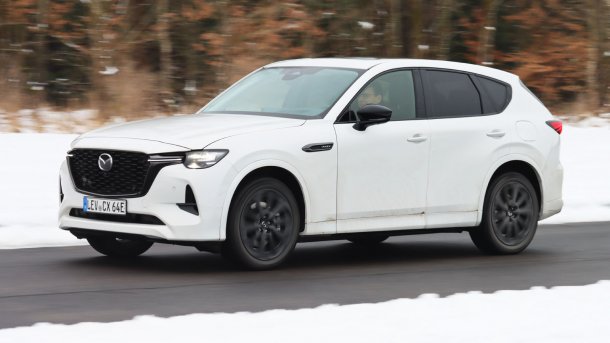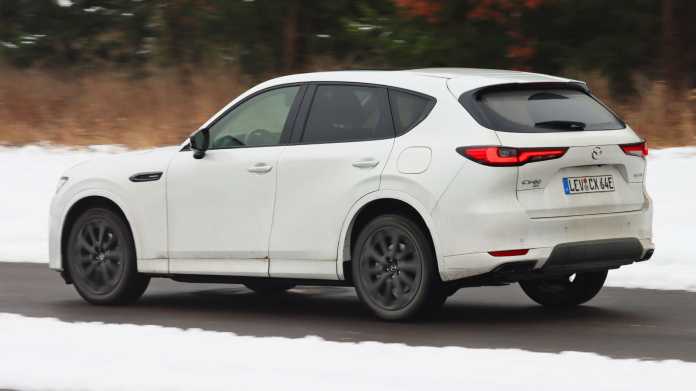Mazda CX-60 PHEV in the test: Plug-in hybrid with rough manners
Mazda's currently largest SUV shows surprising peculiarities in the test. These include not only the selected chassis set-up, but also a rough drive.

(Bild: Pillau)
(Hier finden Sie die deutsche Version des Beitrags)
In recent years, we have had a number of Mazda test cars in the editorial office that all had one thing in common: The common thread, i.e. a basic idea of the specifications, was always recognizable. They were coherent in themselves. Mazda's currently largest SUV on the European market therefore aroused high expectations. The result is surprising, because the CX-60 leaves a surprising amount of room for fine-tuning, especially as a plug-in hybrid.
The SUV does have some promising features. The CX-60 offers a decent amount of space at 4.75 meters. The trunk has a capacity of 570 liters, which probably covers many requirements. The seats could use a bit more lateral support, but they are comfortable and can be adjusted wide enough for big and small. Mazda pays careful attention to a fine lining of the interior, and the workmanship is also impeccable. The Japanese have resisted the now widespread compulsion to have to operate everything via screens and/or touch surfaces. The result is a largely barrier-free functionality. Almost everything is where you instinctively expect it, so you quickly find your way around at the steering wheel.
Mazda CX-60: What do customers expect?
A discussion about format and design will certainly also be held passionately under this SUV test, so only so much at this point: My colleague Florian found the design scary, a neighbor of mine so great that he almost ordered the CX-60. I think it looks better on the inside than on the outside, which doesn't matter to Mazda, because I don't belong to the target group of this format. If I put myself in their shoes and try to imagine what buyers would expect from an SUV of this size, the first thing I would guess is an upscale level of comfort. Mazda obviously came to a different conclusion in customer surveys. In one respect, that may be a matter of taste; in another, not.
Surprisingly loud
Because the CX-60 is surprisingly loud. Even a medium acceleration demand lets the drive come to the fore audibly. It then seems more effortful than it actually is, uncharming entries even left the term "unconfident" in the logbook. Yet the Mazda is by no means a slow car, the driver can access up to 241 kW. However, with its partly droning background noise, the CX-60 ruins a lot for itself in the comfort chapter. In this class, you can expect less noise.
The chassis tuning is also harsh. At some point during the development phase, customers must have wanted an SUV of this size to be able to bounce around corners with as little side lean as possible. This may indeed increase the speed by a few km/h on clean asphalt, but the price is high - and becomes clear every day. That's because the CX-60 passes through a precise underfoot description that's too clear for my taste. Mazda has opted for a tight suspension layout, and the dampers don't respond particularly sensitively to small stimuli. This brings in a restlessness that is surprising in an SUV of this class.
Mazda CX-60 PHEV exterior (6 Bilder)

Especially since the reward for sacrificing comfort is not outstanding driving dynamics. This is matched by the steering, which hardly conveys any road contact and feels synthetic. Mazda can do both, tuning of springs/shocks and steering, much better than served here. CX-5, MX-5 (review), 6 and 3 - we remember them all, each in its own way, as harmoniously tuned cars that we enjoyed driving. No one in the editorial team completely warmed to the CX-60's compromise. Perhaps that's also because no one could answer the question of why a large SUV has to be made up so superficially for dynamics.
Noticeable gear changes
The drive promises opulent driving dynamics. Despite an unladen weight of around 2.1 tons, the CX-60 PHEV accelerates from a standstill to 100 km/h in just 5.8 seconds. It is often faster than the strained roar would suggest. There are plenty of reserves, but the excellent acceleration capacity is rarely fully utilized in normal traffic. However, Mazda can work on how this is presented. The direct and thus hard design of the converter in the eight-speed automatic is good for fuel consumption, but it can't conceal gear changes smoothly. Interruptions in tractive power are thus very noticeable, which is also detrimental to comfort. The electric motor should actually be able to smooth such transitions, but Mazda did not take advantage of this opportunity.
Mazda CX-60 PHEV Technology (4 Bilder)

This works better in electric mode, which is the more pleasant mode anyway. Requests for more speed are processed more spontaneously than with an "empty" battery. In hybrid mode, the control unit may allow itself a moment of inspiration in which the right gear ratio is sought before it then moves forward emphatically.
Large four-cylinder without supercharging
As so often, Mazda has opted for an unusual solution for the combustion engine. The four-cylinder engine has a displacement of 2.5 liters, and the stroke is quite long at 100 mm. There is no turbocharging, which can be seen in the torque, among other things: 261 Nm is not lavish for the displacement class, and it is only available at 4000 rpm. This explains the need to downshift even at comparatively gentle acceleration targets to let the gasoline engine rev up. The combustion engine has an output of 141 kW, the electric motor 129.
It would be obvious to integrate the e-motor more in the lower speed range to improve the subjective impression and the actual acceleration. Here we can only hope for an update that harmonizes the interaction of the two motors with the transmission. The systems are all there, and if someone can find someone to soften the converter in the eight-speed automatic a bit, this could be a very pleasant drive.
Two-phase charger
Plug-in hybrids make it differently difficult for the user to use them electrically. VW and some BMWs, for example, only allow a maximum charging power of 3.7 kW to date. In many PHEV models, the charger is designed as a single-phase unit - on a conventional 11-kW wallbox, which distributes its charging power over three phases, the limit is also 3.7 kW. Mazda does it much better: A two-phase charger is installed in the CX-60, which also allows the maximum 7.2 kW at home. The 176 kg battery is rated at 17.8 kWh gross. In the test, the gasoline engine partly started up again at 26 percent residual charge; we could not discharge the storage lower than 19 percent SoC.